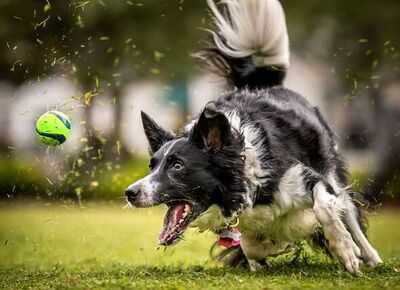Playing fetch is one of the quintessential ways dog owners bond with their pets. The thrill of watching a dog sprint across a park, tongue lolling and ears flapping, is one of the highlights of having a pet - but according to veterinary experts, it isn't without risks.
A guide from Cornell University's College of Veterinary Medicine offers a closer look at how to play ball safely and avoid injuries that can have lasting effects.
Most dogs seem to have limitless stamina. They can run for hours, while their owners' arms or legs may tire after just a few throws. Dr. Chris Zink, director of molecular and comparative pathobiology at Johns Hopkins School of Medicine, stresses that mental exhaustion can be just as effective - if not more - than physical exertion.
Encouraging your dog to use their brain can wear them out while reducing the strain on muscles, joints and ligaments.
One key piece of advice is to control the start and stop of the game. Dogs should wait until the ball or toy has landed before chasing it. Running at full speed with abrupt stops or sharp turns increases the risk of injuries such as sprains, strains, or more serious damage to joints.
Similarly, letting your dog leap into the air to catch a toy might look impressive, but repeated jumps and twists can cause both acute injuries and long-term problems.
Adding a mental challenge can make fetch safer and more stimulating. Tossing the ball into tall grass or brush forces your dog to rely on both sight and scent, keeping their mind engaged.
The act of searching can be just as tiring as the sprint itself, making this an excellent way to burn energy while minimising physical stress.
Dr. Zink also emphasises the importance of overall fitness. A dog with strong muscles, flexible joints, and a healthy weight is far less likely to suffer injuries during play.

Stretching exercises, muscle-strengthening routines, and aerobic activities complement the occasional game of fetch.
Choosing the right toy is equally crucial. A small tennis ball may pose a choking hazard for a large dog, while long sticks can cause injuries if a dog trips while running with them.
Perhaps the simplest guideline is to stop before your dog becomes too tired. Dr. Zink points to a handy visual cue: the "tongue spoon."
If the edges of a dog's tongue curl or widen, it is trying to increase the surface area for panting, signalling that its muscles are nearing overload. Continuing play past this point significantly raises the chance of an accident.
You may also like

Who is Emiru? Exploring the personal life of the popular streamer who was allegedly assaulted at TwitchCon

Daniil Medvedev makes emotional family comment after first title win in 882 days

'Masterpiece' movie is the 'most important war film of all time' - now on Amazon Prime

Why Rangers' deal for Kevin Muscat fell apart as board draw up new manager names

Adin Ross Net Worth 2025: Kick Deal, Mansion, and Monthly Income Breakdown






